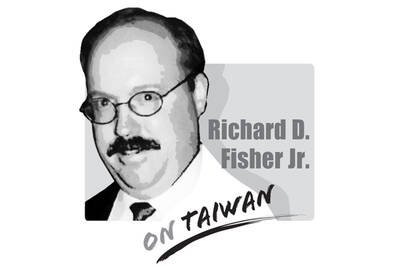A year ago yesterday, scores of university students and others, unarmed yet loaded with indignation over their futures being increasingly dictated by China and with a yearning for change, stormed into the Legislative Yuan’s main chamber in Taipei and started a 24-day occupation that has since been termed the Sunflower movement.
Just as sunflowers turn to follow the sun — symbolizing positivity, openness and brightness — the pursuit of social justice and an acute sense of awareness about the challenges they and the nation face have been the light leading the many young faces to take bold steps in voicing their anger about arbitrary policymaking spearheaded by the Chinese Nationalist Party (KMT) government.
They cannot accept KMT legislators attempting to ram through bills that matter to the nation’s future in a mere 30 seconds, nor can they accept President Ma Ying-jeou’s (馬英九) administration attempting to pass the controversial cross-strait service trade agreement without legislative reviews or public scrutiny.
The protesters and their supporters were also indignant at the growing income disparity in the nation, which leads many to see little hope for a bright future.
A year has passed since the Sunflower movement erupted, and despite attempts by the Ma administration and some media outlets to portray the student-led protesters as rioters, the radiance of the sunflowers’ bright petals continues to foster strong civic engagement among the public. The movement and its effects have altered the nation’s political map.
For example, the KMT was bruised and battered in the nine-in-one elections in November last year. Also, a third political force has emerged, since many young people have — on their own initiative — formed new social activist groups, such as Taiwan March (島國前進), Democracy Kuroshio (民主黑潮) and Democracy Tautin (民主鬥陣).
Indeed, negative perceptions of young Taiwanese have been substantially changed in the wake of the Sunflower movement.
In the past, younger people — often said to display an apathetic attitude toward their surroundings — had been criticized as being spoiled and selfish people who enjoy the fruits of democracy without thinking of how they might contribute to or consolidate the nation’s democratic achievements.
Through the Sunflower movement, the youth have showed a remarkable level of resilience and maturity, as well as a depth of understanding about the nation’s democratization.
The movement has forced the KMT, as well as China, to readjust attitudes toward cross-strait affairs, just as the younger generations must pay attention to social issues as they learn to scrutinize government actions and keep it in check.
Most importantly, young people have shown an adamant and uncompromising attitude toward upholding democratic values and social justice.
A floral symbol of adoration and embracing new opportunities as well as a reminder of all that is good in life, sunflowers certainly have been a great symbol to represent the student-led protesters’ massive demonstrations in March last year against the government’s opaque handling of the service trade agreement.
With their tall stalks and bright petals stretched toward the sun, sunflowers evoke feelings of vibrance and radiant warmth. As such, society looks forward to the sunflowers’ luminescence continuing to uplift the social and political awareness of young people, leading them toward the continued pursuit of critically important national issues and increased civic engagement.
We are used to hearing that whenever something happens, it means Taiwan is about to fall to China. Chinese President Xi Jinping (習近平) cannot change the color of his socks without China experts claiming it means an invasion is imminent. So, it is no surprise that what happened in Venezuela over the weekend triggered the knee-jerk reaction of saying that Taiwan is next. That is not an opinion on whether US President Donald Trump was right to remove Venezuelan President Nicolas Maduro the way he did or if it is good for Venezuela and the world. There are other, more qualified
China’s recent aggressive military posture around Taiwan simply reflects the truth that China is a millennium behind, as Kobe City Councilor Norihiro Uehata has commented. While democratic countries work for peace, prosperity and progress, authoritarian countries such as Russia and China only care about territorial expansion, superpower status and world dominance, while their people suffer. Two millennia ago, the ancient Chinese philosopher Mencius (孟子) would have advised Chinese President Xi Jinping (習近平) that “people are the most important, state is lesser, and the ruler is the least important.” In fact, the reverse order is causing the great depression in China right now,

This should be the year in which the democracies, especially those in East Asia, lose their fear of the Chinese Communist Party’s (CCP) “one China principle” plus its nuclear “Cognitive Warfare” coercion strategies, all designed to achieve hegemony without fighting. For 2025, stoking regional and global fear was a major goal for the CCP and its People’s Liberation Army (PLA), following on Mao Zedong’s (毛澤東) Little Red Book admonition, “We must be ruthless to our enemies; we must overpower and annihilate them.” But on Dec. 17, 2025, the Trump Administration demonstrated direct defiance of CCP terror with its record US$11.1 billion arms
The immediate response in Taiwan to the extraction of Venezuelan President Nicolas Maduro by the US over the weekend was to say that it was an example of violence by a major power against a smaller nation and that, as such, it gave Chinese President Xi Jinping (習近平) carte blanche to invade Taiwan. That assessment is vastly oversimplistic and, on more sober reflection, likely incorrect. Generally speaking, there are three basic interpretations from commentators in Taiwan. The first is that the US is no longer interested in what is happening beyond its own backyard, and no longer preoccupied with regions in other